牛津深圳版英语九年级下册 Unit 4 Natural disasters单元基础过关习题课件(共29张PPT)
文档属性
| 名称 | 牛津深圳版英语九年级下册 Unit 4 Natural disasters单元基础过关习题课件(共29张PPT) | 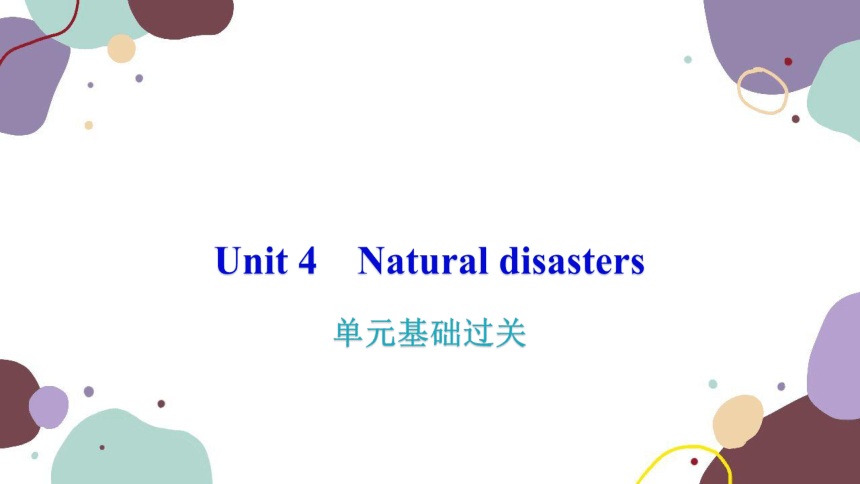 | |
| 格式 | pptx | ||
| 文件大小 | 244.6KB | ||
| 资源类型 | 教案 | ||
| 版本资源 | 牛津深圳版 | ||
| 科目 | 英语 | ||
| 更新时间 | 2023-08-04 08:40:58 | ||
图片预览

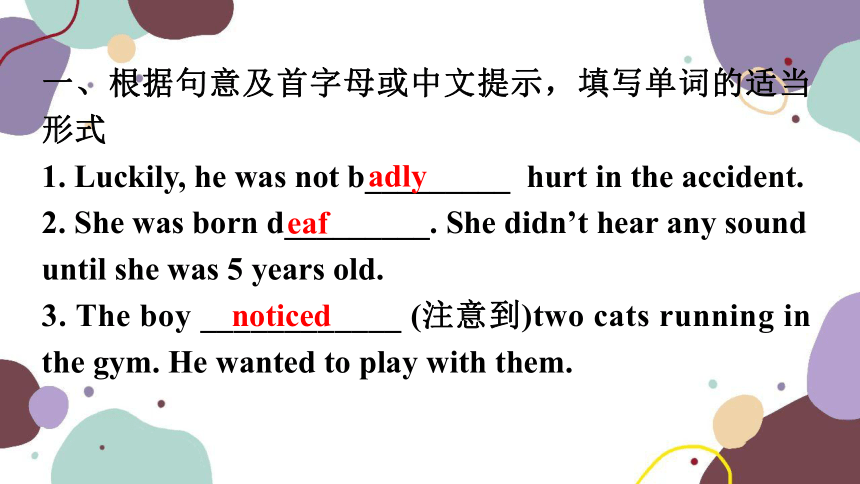
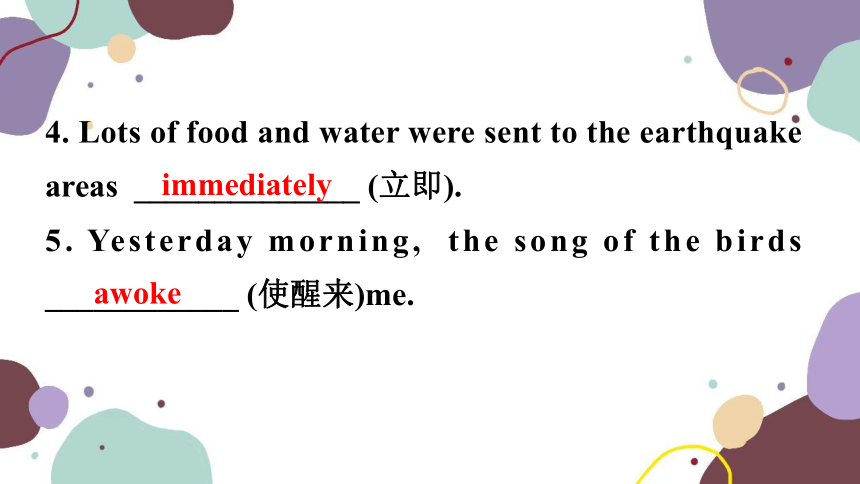
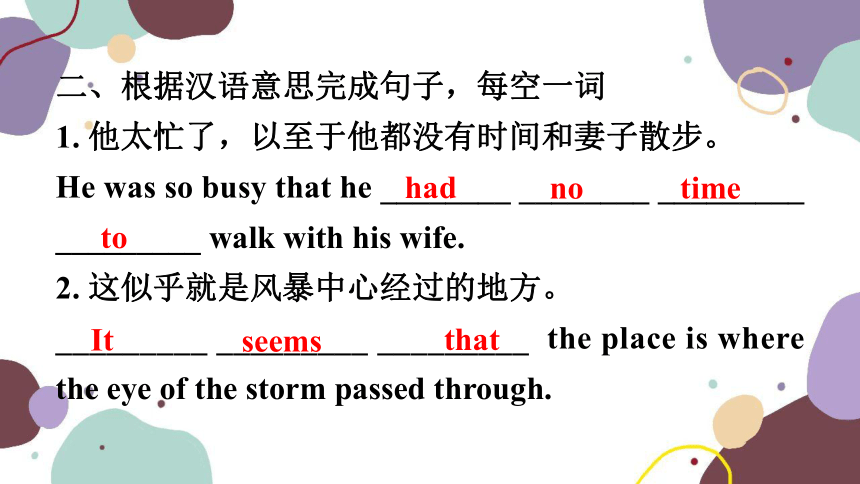

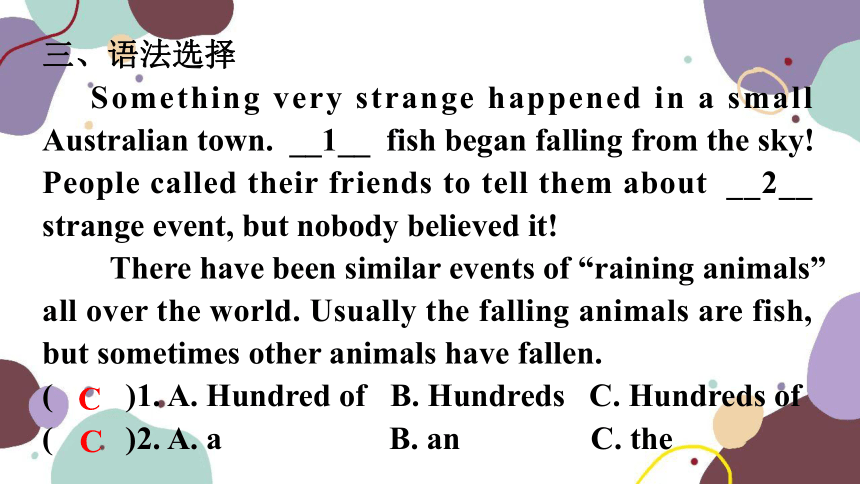
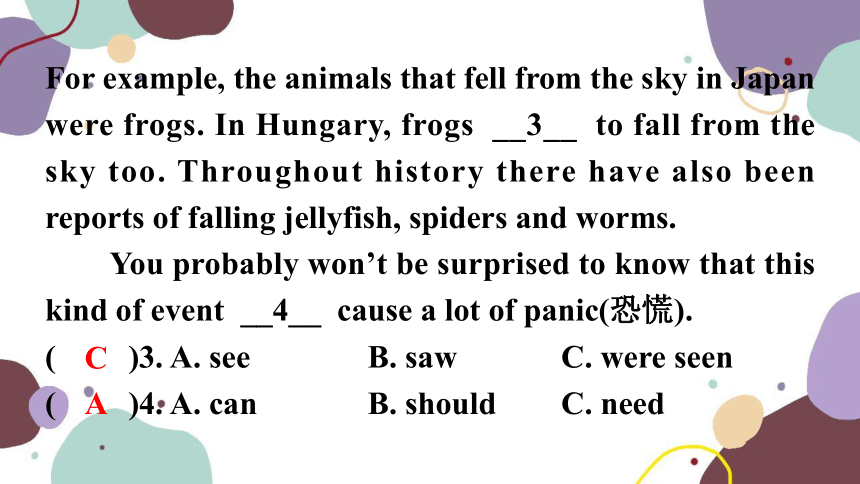
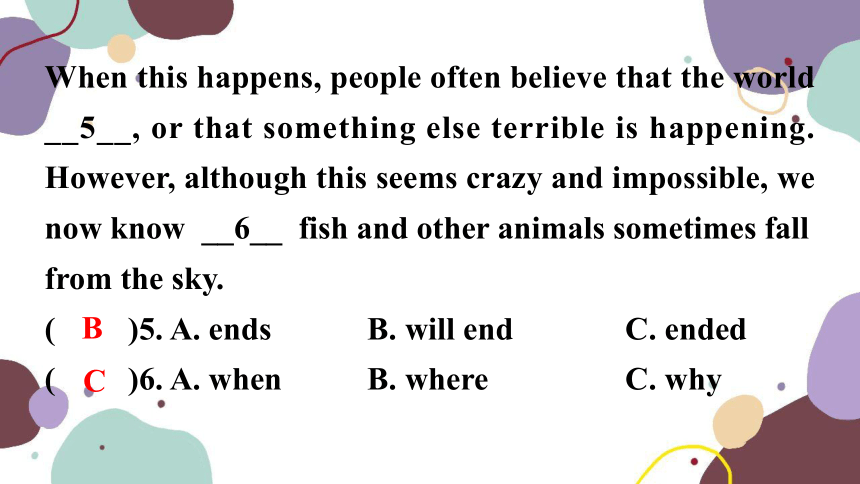
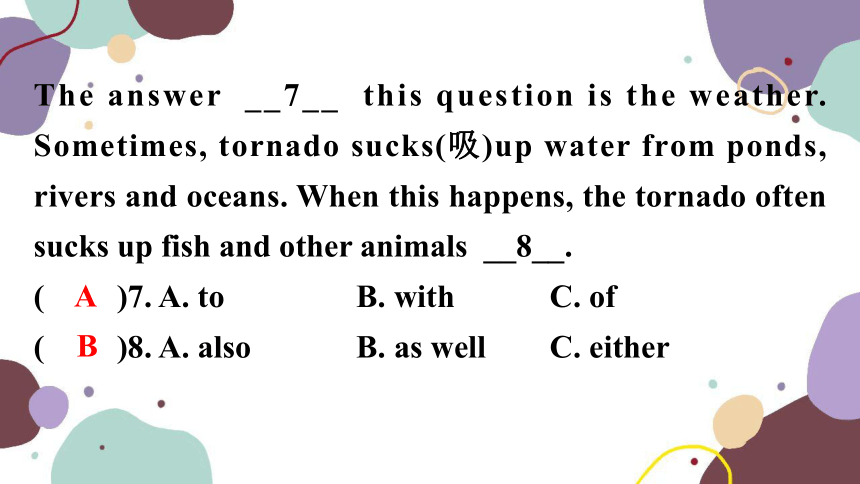
文档简介
(共29张PPT)
Unit 4 Natural disasters
单元基础过关
一、根据句意及首字母或中文提示,填写单词的适当形式
1. Luckily, he was not b_________ hurt in the accident.
2. She was born d_________. She didn’t hear any sound until she was 5 years old.
3. The boy ____________ (注意到)two cats running in the gym. He wanted to play with them.
adly
eaf
noticed
4. Lots of food and water were sent to the earthquake areas ______________ (立即).
5. Yesterday morning, the song of the birds ____________ (使醒来)me.
immediately
awoke
二、根据汉语意思完成句子,每空一词
1. 他太忙了,以至于他都没有时间和妻子散步。
He was so busy that he ________ ________ _________ _________ walk with his wife.
2. 这似乎就是风暴中心经过的地方。
_________ _________ _________ the place is where the eye of the storm passed through.
had
no
time
to
It
seems
that
3. 坚持自己喜欢做的事情是很重要的。
It is important to ____________ _________ what you like to do.
4. 当这件艺术品在博物馆展出时,人们都很惊讶地看着它。
When the work of art is on show in the museum, people look at it ____________ ____________.
5. 他努力使自己平静下来,但他的心跳得很快。
He was trying to ____________ ____________, but his heart was beating very fast.
stick
with
in
surprise
as
stay
calm
三、语法选择
Something very strange happened in a small Australian town. __1__ fish began falling from the sky! People called their friends to tell them about __2__ strange event, but nobody believed it!
There have been similar events of “raining animals” all over the world. Usually the falling animals are fish, but sometimes other animals have fallen.
( )1. A. Hundred of B. Hundreds C. Hundreds of
( )2. A. a B. an C. the
C
C
For example, the animals that fell from the sky in Japan were frogs. In Hungary, frogs __3__ to fall from the sky too. Throughout history there have also been reports of falling jellyfish, spiders and worms.
You probably won’t be surprised to know that this kind of event __4__ cause a lot of panic(恐慌).
( )3. A. see B. saw C. were seen
( )4. A. can B. should C. need
C
A
When this happens, people often believe that the world __5__, or that something else terrible is happening. However, although this seems crazy and impossible, we now know __6__ fish and other animals sometimes fall from the sky.
( )5. A. ends B. will end C. ended
( )6. A. when B. where C. why
B
C
The answer __7__ this question is the weather. Sometimes, tornado sucks(吸)up water from ponds, rivers and oceans. When this happens, the tornado often sucks up fish and other animals __8__.
( )7. A. to B. with C. of
( )8. A. also B. as well C. either
A
B
The tornado carries these unlucky animals for a short distance, and then drops them in __9__ place. When fish fall from the sky, they are often still __10__ because tornado doesn’t carry the fish very far.
( )9. A. other B. another C. the other
( )10. A. alive B. live C. lively
B
A
四、完形填空
Typhoons and hurricanes are the same weather phenomenon:tropical cyclones(热带气旋). However,they have different __1__ depending on where they take place.
Typhoons develop in the northwestern part of the Pacific Ocean. They__2__ take place from late June to December.
( )1. A. topics B. names C. speeds D. orders
( )2. A. never B. seldom C. usually D. hardly
B
C
When winds __3__ into warm seawater, a lot of warm and moist air evaporates(蒸发)and rises rapidly, while colder air moves in below. This creates pressure, which causes the winds to move very__4__. The more warm air and moisture there is, the stronger the winds are.
( )3. A. blow B. stare C. increase D. develop
( )4. A. slowly B. carefully C. gently D. quickly
A
D
When the winds move faster than 119 kilometres per hour, a typhoon is__5__. If a typhoon moves over 241 kilometres per hour, then it becomes a super typhoon.
The__6__ of a typhoon is called the“eye”. This is just in the middle of a typhoon. In the “eye”, the wind does not move so fast. Around the “eye” is the wall of clouds.
( )5. A. formed B. helped C. caused D. destroyed
( )6. A. side B. centre C. left D. right
A
B
This is where the __7__ winds and hardest rains are found. The rain bands (雨带)are the outer part of a typhoon.
Typhoons can be very__8__. They __9__ houses and cars, and even kill people.
( )7. A. nicest B. weakest C. strongest D. easiest
( )8. A. wonderful B. dangerous
C. helpful D. useful
( )9. A. break down B. fall down
C. copy down D. write down
C
B
A
For example, tropical storm Megi hit the Philippines in April, 2022. More than 210 people died in the typhoon.
China is also one of the countries most affected by typhoons. The peak time for typhoons landing is from July to September. On average, China’s coastal(沿海的) people __10__ ten typhoon landings each year.
( )10. A. use B. get C. take D. face
D
五、阅读理解(B篇)
Volcanoes are threats all over the world. It can kill lots of people when it erupts. But some scientists have new ways to tell when they will erupt. Let’s learn about what a volcano is and high-tech detectives about volcanoes.
What are volcanoes
A volcano is a crack on Earth. The opening is caused by gas and hot liquid rocks, called magma(岩浆). The gas and magma rise from deep inside the Earth. A volcano
erupts when gas and magma push through the Earth’s surface. Magma that flows out of the ground is called lava(岩浆). Lava can sometimes build up around a volcano and form a cone-shaped mountain. Lava can also pour along the ground, destroying everything in its path.
High-tech detectives
The good news is that scientists can now help keep people safe. Scientists can get to an active volcano within 48 hours of the first sign of trouble. Researchers also have new ways to know when a volcano may erupt. They use
satellites to watch volcanoes. They put sensors(传感器) at the base of a volcano. Then they tune them to a satellite circling the Earth. The sensors feel rumbles(隆隆声) as magma and gases move inside the volcano. The satellites find the location of each sensor. A computer puts the information together to make a picture of inside the mountain.
These tools help scientists and researchers study the volcanoes and predict(预测) when a volcano may erupt.
( )1. What does the underlined word “threats” in the passage mean
A. Facts. B. Troubles. C. Chances. D. Topics.
( )2. What CANNOT lava do according to the passage
A. Help predict when a volcano may take place.
B. Destroy the things in its path.
C. Build up around a volcano.
D. Form a certain shape of mountain.
A
B
( )3. What do researchers use to watch volcanoes
A. Satellites. B. Computers.
C. Sensors. D. Pictures.
( )4. What is the purpose of the passage
A. To ask us to keep away from volcanoes.
B. To teach us how to keep safe when volcanoes erupt.
C. To tell us something about volcanoes and how to predict the eruption of volcanoes.
D. To encourage us to do more research on volcanoes.
A
C
( )5. In which column of a magazine can you read this passage
A. Safety.
B. Weather.
C. Environmental protection.
D. Natural disasters.
D
【拓展练习】再次阅读文章,回答下列5个问题,并把答案写在横线上。
1. What is a volcano
_______________________________________________
2. When does a volcano erupt
_______________________________________________
_______________________________________________
_______________________________________________
A volcano / It is a crack on Earth. / A crack on Earth.
A volcano / It erupts when gas and magma push through the Earth’s surface. / When gas and magma push through the Earth’s surface.
3. How soon can scientists get to an active volcano
_______________________________________________
_______________________________________________
_______________________________________________
4. What are put at the base of a volcano, satellites or sensors
_______________________________________________
Scientists / They can get to an active volcano / it within 48 hours of the first sign of trouble. / Within 48 hours of the first sign of trouble.
Sensors are put at the base of a volcano. / Sensors.
5. Why are the tools useful
_______________________________________________
_______________________________________________
_______________________________________________
Because the tools / they help scientists and researchers study the volcanoes and predict when a volcano may erupt.
六、短文填空
Have you heard of the sandstorm A sandstorm is __1__ common natural disaster. Sandstorms are __2__ strong that they can blow a person from 1 to 1.5 metres away from where he is standing. They are common in Northwest China where there are large deserts and __3__ forests.
a
so
few
The sandstorms often hit parts of Northwest China __4__ spring. __5__ do great harm to many plants and houses. And they affect the lives of millions __6__ people.
“Before the sandstorm, the weather was __7__ and it didn’t even begin to get dark,” said a person from Minqin, Gansu. “But the next thing you knew, the strong __8__ brought heavy sand and blew at me, like a wall
in
They
of
fine
wind
of sand, and the sky suddenly became dark.” “The wind was very loud, and it woke me up that night and I couldn’t __9__ asleep again,” said Li Ying from Inner Mongolia. “After I got up and looked outside in the morning, I was surprised to see that there was yellow sand __10__.”
fall
everywhere
1. __________________ 2. __________________
3. __________________ 4. __________________
5. __________________ 6. __________________
7. __________________ 8. __________________
9. __________________ 10. __________________
a
so
of
in
They
of
fine
wind
fall
everywhere
THANKS!
Unit 4 Natural disasters
单元基础过关
一、根据句意及首字母或中文提示,填写单词的适当形式
1. Luckily, he was not b_________ hurt in the accident.
2. She was born d_________. She didn’t hear any sound until she was 5 years old.
3. The boy ____________ (注意到)two cats running in the gym. He wanted to play with them.
adly
eaf
noticed
4. Lots of food and water were sent to the earthquake areas ______________ (立即).
5. Yesterday morning, the song of the birds ____________ (使醒来)me.
immediately
awoke
二、根据汉语意思完成句子,每空一词
1. 他太忙了,以至于他都没有时间和妻子散步。
He was so busy that he ________ ________ _________ _________ walk with his wife.
2. 这似乎就是风暴中心经过的地方。
_________ _________ _________ the place is where the eye of the storm passed through.
had
no
time
to
It
seems
that
3. 坚持自己喜欢做的事情是很重要的。
It is important to ____________ _________ what you like to do.
4. 当这件艺术品在博物馆展出时,人们都很惊讶地看着它。
When the work of art is on show in the museum, people look at it ____________ ____________.
5. 他努力使自己平静下来,但他的心跳得很快。
He was trying to ____________ ____________, but his heart was beating very fast.
stick
with
in
surprise
as
stay
calm
三、语法选择
Something very strange happened in a small Australian town. __1__ fish began falling from the sky! People called their friends to tell them about __2__ strange event, but nobody believed it!
There have been similar events of “raining animals” all over the world. Usually the falling animals are fish, but sometimes other animals have fallen.
( )1. A. Hundred of B. Hundreds C. Hundreds of
( )2. A. a B. an C. the
C
C
For example, the animals that fell from the sky in Japan were frogs. In Hungary, frogs __3__ to fall from the sky too. Throughout history there have also been reports of falling jellyfish, spiders and worms.
You probably won’t be surprised to know that this kind of event __4__ cause a lot of panic(恐慌).
( )3. A. see B. saw C. were seen
( )4. A. can B. should C. need
C
A
When this happens, people often believe that the world __5__, or that something else terrible is happening. However, although this seems crazy and impossible, we now know __6__ fish and other animals sometimes fall from the sky.
( )5. A. ends B. will end C. ended
( )6. A. when B. where C. why
B
C
The answer __7__ this question is the weather. Sometimes, tornado sucks(吸)up water from ponds, rivers and oceans. When this happens, the tornado often sucks up fish and other animals __8__.
( )7. A. to B. with C. of
( )8. A. also B. as well C. either
A
B
The tornado carries these unlucky animals for a short distance, and then drops them in __9__ place. When fish fall from the sky, they are often still __10__ because tornado doesn’t carry the fish very far.
( )9. A. other B. another C. the other
( )10. A. alive B. live C. lively
B
A
四、完形填空
Typhoons and hurricanes are the same weather phenomenon:tropical cyclones(热带气旋). However,they have different __1__ depending on where they take place.
Typhoons develop in the northwestern part of the Pacific Ocean. They__2__ take place from late June to December.
( )1. A. topics B. names C. speeds D. orders
( )2. A. never B. seldom C. usually D. hardly
B
C
When winds __3__ into warm seawater, a lot of warm and moist air evaporates(蒸发)and rises rapidly, while colder air moves in below. This creates pressure, which causes the winds to move very__4__. The more warm air and moisture there is, the stronger the winds are.
( )3. A. blow B. stare C. increase D. develop
( )4. A. slowly B. carefully C. gently D. quickly
A
D
When the winds move faster than 119 kilometres per hour, a typhoon is__5__. If a typhoon moves over 241 kilometres per hour, then it becomes a super typhoon.
The__6__ of a typhoon is called the“eye”. This is just in the middle of a typhoon. In the “eye”, the wind does not move so fast. Around the “eye” is the wall of clouds.
( )5. A. formed B. helped C. caused D. destroyed
( )6. A. side B. centre C. left D. right
A
B
This is where the __7__ winds and hardest rains are found. The rain bands (雨带)are the outer part of a typhoon.
Typhoons can be very__8__. They __9__ houses and cars, and even kill people.
( )7. A. nicest B. weakest C. strongest D. easiest
( )8. A. wonderful B. dangerous
C. helpful D. useful
( )9. A. break down B. fall down
C. copy down D. write down
C
B
A
For example, tropical storm Megi hit the Philippines in April, 2022. More than 210 people died in the typhoon.
China is also one of the countries most affected by typhoons. The peak time for typhoons landing is from July to September. On average, China’s coastal(沿海的) people __10__ ten typhoon landings each year.
( )10. A. use B. get C. take D. face
D
五、阅读理解(B篇)
Volcanoes are threats all over the world. It can kill lots of people when it erupts. But some scientists have new ways to tell when they will erupt. Let’s learn about what a volcano is and high-tech detectives about volcanoes.
What are volcanoes
A volcano is a crack on Earth. The opening is caused by gas and hot liquid rocks, called magma(岩浆). The gas and magma rise from deep inside the Earth. A volcano
erupts when gas and magma push through the Earth’s surface. Magma that flows out of the ground is called lava(岩浆). Lava can sometimes build up around a volcano and form a cone-shaped mountain. Lava can also pour along the ground, destroying everything in its path.
High-tech detectives
The good news is that scientists can now help keep people safe. Scientists can get to an active volcano within 48 hours of the first sign of trouble. Researchers also have new ways to know when a volcano may erupt. They use
satellites to watch volcanoes. They put sensors(传感器) at the base of a volcano. Then they tune them to a satellite circling the Earth. The sensors feel rumbles(隆隆声) as magma and gases move inside the volcano. The satellites find the location of each sensor. A computer puts the information together to make a picture of inside the mountain.
These tools help scientists and researchers study the volcanoes and predict(预测) when a volcano may erupt.
( )1. What does the underlined word “threats” in the passage mean
A. Facts. B. Troubles. C. Chances. D. Topics.
( )2. What CANNOT lava do according to the passage
A. Help predict when a volcano may take place.
B. Destroy the things in its path.
C. Build up around a volcano.
D. Form a certain shape of mountain.
A
B
( )3. What do researchers use to watch volcanoes
A. Satellites. B. Computers.
C. Sensors. D. Pictures.
( )4. What is the purpose of the passage
A. To ask us to keep away from volcanoes.
B. To teach us how to keep safe when volcanoes erupt.
C. To tell us something about volcanoes and how to predict the eruption of volcanoes.
D. To encourage us to do more research on volcanoes.
A
C
( )5. In which column of a magazine can you read this passage
A. Safety.
B. Weather.
C. Environmental protection.
D. Natural disasters.
D
【拓展练习】再次阅读文章,回答下列5个问题,并把答案写在横线上。
1. What is a volcano
_______________________________________________
2. When does a volcano erupt
_______________________________________________
_______________________________________________
_______________________________________________
A volcano / It is a crack on Earth. / A crack on Earth.
A volcano / It erupts when gas and magma push through the Earth’s surface. / When gas and magma push through the Earth’s surface.
3. How soon can scientists get to an active volcano
_______________________________________________
_______________________________________________
_______________________________________________
4. What are put at the base of a volcano, satellites or sensors
_______________________________________________
Scientists / They can get to an active volcano / it within 48 hours of the first sign of trouble. / Within 48 hours of the first sign of trouble.
Sensors are put at the base of a volcano. / Sensors.
5. Why are the tools useful
_______________________________________________
_______________________________________________
_______________________________________________
Because the tools / they help scientists and researchers study the volcanoes and predict when a volcano may erupt.
六、短文填空
Have you heard of the sandstorm A sandstorm is __1__ common natural disaster. Sandstorms are __2__ strong that they can blow a person from 1 to 1.5 metres away from where he is standing. They are common in Northwest China where there are large deserts and __3__ forests.
a
so
few
The sandstorms often hit parts of Northwest China __4__ spring. __5__ do great harm to many plants and houses. And they affect the lives of millions __6__ people.
“Before the sandstorm, the weather was __7__ and it didn’t even begin to get dark,” said a person from Minqin, Gansu. “But the next thing you knew, the strong __8__ brought heavy sand and blew at me, like a wall
in
They
of
fine
wind
of sand, and the sky suddenly became dark.” “The wind was very loud, and it woke me up that night and I couldn’t __9__ asleep again,” said Li Ying from Inner Mongolia. “After I got up and looked outside in the morning, I was surprised to see that there was yellow sand __10__.”
fall
everywhere
1. __________________ 2. __________________
3. __________________ 4. __________________
5. __________________ 6. __________________
7. __________________ 8. __________________
9. __________________ 10. __________________
a
so
of
in
They
of
fine
wind
fall
everywhere
THANKS!
